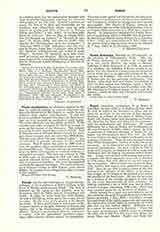

Piazzi, GIUSEPPE, astronomer, b. at Ponte in Valtellina, July 16, 1746; d. at Naples, July 22, 1826. He took the habit of the Theatines at Milan and finished his novitiate at the convent of San Antonio. Studying at colleges of the order at Milan, Turin, Rome, and Genoa, under such preceptors as Tiraboschi, Beccaria, Le Seur, and Jacquier, he acquired a taste for mathematics and astronomy. He taught philosophy for a time at Genoa and mathematics at the new University of Malta while it lasted. In 1779, as professor of dogmatic theology in Rome, his colleague was Chiaramonti, later Pius VII. In 1780 he was called to the chair of higher mathematics at the academy of Palermo. There he soon obtained a grant from Prince Caramanico, Viceroy of Sicily, for an observatory. As its director he was charged to get the necessary instruments. He went to Paris in 1787 to study with Lalande, to England in 1788 to work with Maskelyne and the famous instrument-maker Ramsden. A large vertical circle with reading microscopes, a transit, and other apparatus were sent to Palermo in 1789, where they were placed on top of a tower of the royal palace. Observations were started in May, 1791, and the first reports were published as early as 1792. Soon he was able to correct errors in the estimation of the obliquity of the ecliptic, of the aberration of light, of the length of the tropical year, and of the parallax of the fixed stars. He saw the necessity for a revision of the existing catalogues of stars and for the exact determination of their positions. In 1803 he published a list of 6784 stars and in 1814 a second catalog containing 7646 stars. Both lists were awarded prizes by the Institute of France.
While looking for a small star mentioned in one of the earlier lists he made his great discovery of the first known planetoid, January 1, 1801. Locating a strange heavenly body of the eighth magnitude and repeating the observation several nights in succession, he found that this star had shifted slightly. Believing it to be a comet, he announced its discovery. These few but exact measurements enabled Gauss to calculate the orbit and to find that this was a new planet, between Mars and Jupiter. Kepler and Bode had called attention to the apparent gap between these two, so that the placing of this new body within that space caused great excitement among astronomers. Piazzi proposed the name of Ceres Ferdinandea, in honor of his king. Over 600 of these so-called planetoids have since been located within the same space. The king desired to strike a gold medal with Piazzi’s effigy, in commemoration, but the astronomer requested the privilege of using the money for the purpose of a much-needed equatorial telescope. In 1812 he received the commission to reform the weights and measures of Sicily in accordance with the metric system. In 1817 as director-general of the observatories of the Two Sicilies he was charged with the plans of the new observatory which Murat was establishing in Naples. He was a member of the Academies of Naples, Turin, Gottingen, Berlin, and St. Petersburg, foreign associate of the Institute of Milan etc. Besides the numerous memoirs published in the proceedings of the various academies, the following works may be mentioned: “Della specola astronomica di Palermo libri quatro” (Palermo, 1792); “Sull’ orologio Italiano e l’Europeo” (Palermo, 1798); “Della scoperta del nuovo planeta Cerere Ferdinandea” (Palermo, 1802); “Pnecipuarum stellarum inerrantium positiones mediae ineunte seculo XIX ex observationibus habitis in specula Panormitana at 1793 ad 1802” (Palermo, 1803, 1814); “Codice metrico siculo” (Catane, 1812); “Lezioni di astronomia” (Palermo, 1817; tr. Westphal, Berlin, 1822); “Raggnaglio dal reale osservatorio d’Napoli” (Naples, 1821).
WILLIAM FOX

